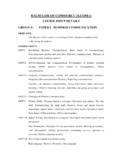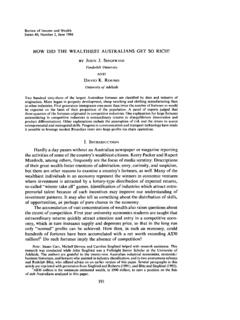Transcription of UNDERSTANDING THE EFFECTS OF GOVERNMENT …
1 Zwu001070405 2007/1/24 page 227 #1 UNDERSTANDING THE EFFECTSOF GOVERNMENT SPENDINGON CONSUMPTIONJ ordi Gal CREI and Universitat Pompeu FabraJ. David L pez-SalidoFederal Reserve BoardJavier Vall sEconomic Bureau of SpanishPrime MinisterAbstractRecent evidence suggests that consumption rises in response to an increase in governmentspending. That finding cannot be easily reconciled with existing optimizing business cyclemodels. We extend the standard new Keynesian model to allow for the presence of rule-of-thumbconsumers. We show how the interaction of the latter with sticky prices and deficit financingcan account for the existing evidence on the EFFECTS of GOVERNMENT spending . (JEL: E32, E62)1. IntroductionWhat are the EFFECTS of changes in GOVERNMENT purchases on aggregate economicactivity? How are those EFFECTS transmitted? Even though such questions arecentral to macroeconomics and its ability to inform economic policy, there is nowidespread agreement on their answer.
2 In particular, though most macroeconomicmodels predict that a rise in GOVERNMENT purchases will have an expansion-ary effect on output, those models often differ regarding the implied EFFECTS onconsumption. Because the latter variable is the largest component of aggregateAcknowledgments: We wish to thank Alberto Alesina, Javier Andr s, Florin Bilbiie, G nterCoenen, Gabriel Fagan, Eric Leeper, Ilian Mihov, Valery Ramey, Michael Reiter, Jaume Ventura,Lutz Weinke, co-editor Roberto Perotti, two anonymous referees, and seminar participants at theBank of Spain, Bank of England, CREI-UPF, IGIER-Bocconi, INSEAD, York, Salamanca, NBERS ummer Institute 2002, the 1st Workshop on Dynamic Macroeconomics at Hydra, the EEA Meetingsin Stockholm, and the 2nd International Research Forum on Monetary Policy for useful commentsand suggestions. Gal acknowledges the financial support and hospitality of the Banco de Espa a,and CREA-Barcelona Economics and MCyT (grant SEJ 2005-01124) for research support.
3 AntonNakov provided excellent research assistance. This paper was written while the last two authorsworked at the Research Department of the Banco de Espa a. The opinions and analyses are theresponsibility of the authors and, therefore, do not necessarily coincide with those of the Banco deEspa a, the Eurosystem, the Board of Governors of the Federal Reserve System, or any other personassociated with the Federal Reserve addresses: Gal : L pez-Salido: and Vall of the European Economic AssociationMarch 2007 5(1):227 270 2007 by the European Economic Association zwu001070405 2007/1/24 page 228 #2228 Journal of the European Economic Associationdemand, its response is a key determinant of the size of the GOVERNMENT standard RBC and the textbook IS-LM models provide a stark exampleof such differential qualitative predictions. The standard RBC model generallypredicts a decline in consumption in response to a rise in GOVERNMENT purchasesof goods and services (henceforth, GOVERNMENT spending , for short).
4 In contrast,the IS-LM model predicts that consumption should rise, hence amplifying theeffects of the expansion in GOVERNMENT spending on output. Of course, the rea-son for the differential impact across those two models lies in how consumersare assumed to behave in each case. The RBC model features infinitely-livedRicardian households, whose consumption decisions at any point in time arebased on an intertemporal budget constraint. Ceteris paribus, an increase in gov-ernment spending lowers the present value of after-tax income, thus generatinga negative wealth effect that induces a cut in way of contrast,in the IS-LM model consumers behave in a non-Ricardian fashion, with theirconsumption being a function of their current disposable income and not of theirlifetime resources. Accordingly, the implied effect of an increase in governmentspending will depend critically on how the latter is financed, with the multiplierincreasing with the extent of deficit does the existing empirical evidence have to say regarding the con-sumption EFFECTS of changes in GOVERNMENT spending ?
5 Can it help discriminatebetween the two paradigms, on the grounds of the observed response of consump-tion? A number of recent empirical papers shed some light on those all apply multivariate time series methods in order to estimate the responsesof consumption and a number of other variables to an exogenous increase ingovernment spending . They differ, however, on the assumptions made in orderto identify the exogenous component of that variable. In Section 2 we describein some detail the findings from that literature that are most relevant to our pur-poses, and provide some additional empirical results of our own. In particular,1. The mechanisms underlying those EFFECTS are described in detail in Aiyagari, Christiano, andEichenbaum (1990), Baxter and King (1993), Christiano and Eichenbaum (1992), and Fat s andMihov (2001), among others. In a nutshell, an increase in (non-productive) GOVERNMENT purchases,financed by current or future lump-sum taxes, has a negative wealth effect which is reflected in lowerconsumption.
6 It also induces a rise in the quantity of labor supplied at any given wage. The lattereffect leads, in equilibrium, to a lower real wage, higher employment and higher output. The increasein employment leads, if sufficiently persistent, to a rise in the expected return to capital, and maytrigger a rise in investment. In the latter case the size of the multiplier is greater or less than one,depending on parameter See, for example, Blanchard (2003). The total effect on output will also depend on the investmentresponse. Under the assumption of a constant money supply, generally maintained in textbookversions of that model, the rise in consumption is accompanied by an investment decline (resultingfrom a higher interest rate). If instead the central bank holds the interest rate steady in the face of theincrease in GOVERNMENT spending , the implied effect on investment is nil. However, any intermediate response of the central bank ( , one that does not imply full accommodation of the higher moneydemand induced by the rise in output) will also induce a fall in investment in the IS-LM model.
7 Zwu001070405 2007/1/24 page 229 #3 Gal et al. EFFECTS of GOVERNMENT spending on Consumption229and like several other authors that preceded us, we find that a positive governmentspending shock leads to a significant increase in consumption , while investmenteither falls or does not respond significantly. Thus, our evidence seems to be con-sistent with the predictions of models with non-Ricardian consumers and hard toreconcile with those of the neoclassical reviewing the evidence, we turn to our paper s main contribution: Thedevelopment of a simple dynamic general equilibrium model that can potentiallyaccount for that evidence. Our framework shares many ingredients with recentdynamic optimizing sticky price models, though we modify the latter by allow-ing for the presence ofrule-of-thumbbehavior by some and Mankiw (1989), we assume that rule-of-thumb consumers do notborrow or save; instead, they are assumed to consume their current income our model, rule-of-thumb consumers coexist with conventional infinite-horizonRicardian introduction of rule-of-thumb consumers in our model is motivated by anextensive empirical literature pointing to substantial deviations from the perma-nent income hypothesis.
8 Much of that literature provides evidence of excessive dependence of consumption on current income. That evidence is based on theanalysis of aggregate time series,4as well as natural experiments using microdata ( , response to anticipated tax refunds).5 That evidence also seems consis-tent with the observation that a significant fraction of households have near-zeronet the basis of that evidence, Mankiw (2000) calls for the systematicincorporation of non-Ricardian households in macroeconomic models, and foran examination of the policy implications of their further explained below, the existence of non-Ricardian households cannotin itself generate a positive response of consumption to a rise in governmentspending. To see this, consider the following equilibrium conditionmp nt= t+ct+ nt,wheremp nt,ct, andntrepresent the (logs) of the marginal product of labor, con-sumption, and hours worked, respectively.
9 The termct+ ntrepresents the (log)marginal rate of substitution, with parameter >0 measuring the curvature of themarginal disutility of labor. Variable tis thus the wedge between the marginalrate of substitution and the marginal product of labor, and can be interpreted asthe sum of both the (log) wage and price markups, as discussed in Gal , Gertler,and L pez-Salido (2007).3. See, for example, Rotemberg and Woodford (1999), Clarida, Gal , and Gertler (1999), orWoodford (2003) for a description of the standard new Keynesian See, for example, Campbell and Mankiw (1989) and Deaton (1992) and references See, for example, Souleles (1999) and Johnson, Parker, and Souleles (2004).6. See, for example, Wolff (1998). zwu001070405 2007/1/24 page 230 #4230 Journal of the European Economic AssociationConsider first an economy with a constant wedge, t= for allt. Noticethat the particular case of =0 corresponds to the perfectly competitive caseoften assumed in the RBC literature.
10 According to both theory and evidence, anincrease in GOVERNMENT purchases raises hours and, under standard assumptions,lowers the marginal product of labor. Thus, it follows that consumption mustdrop if the previous condition is to be satisfied. Hence, a necessary condition forconsumption to rise in response to a fiscal expansion is the existence of a simulta-neous decline in the wedge t. This motivates the introduction in our frameworkof the assumption of sticky prices in goods markets and, at least in one versionof our model, of imperfectly competitive labor markets. Those complementaryassumptions interact with the presence of non-Ricardian consumers in a way thatmakes it possible to reverse the sign of the response of consumption to changes ingovernment spending . As described subsequently, our model predicts responsesof aggregate consumption and other variables that are in line with the existingevidence, given plausible calibrations of the fraction of rule-of-thumb consumers,the degree of price stickiness, and the extent of deficit the narrower focus of the present paper, a simple lesson emergesfrom our analysis: Allowing for deviations from the strict Ricardian behaviorassumed in the majority of existing macro models may be required in order tocapture important aspects of the economy s proposed framework,based on the simple model of rule-of-thumb consumers of Campbell and Mankiw(1989), although admittedly ad-hoc, provides in our view a good starting rest of the paper is organized as follows.



